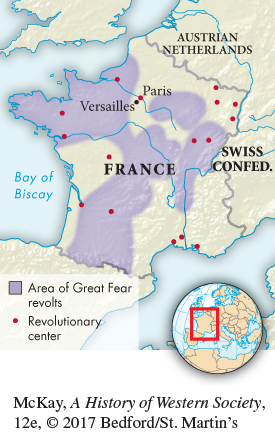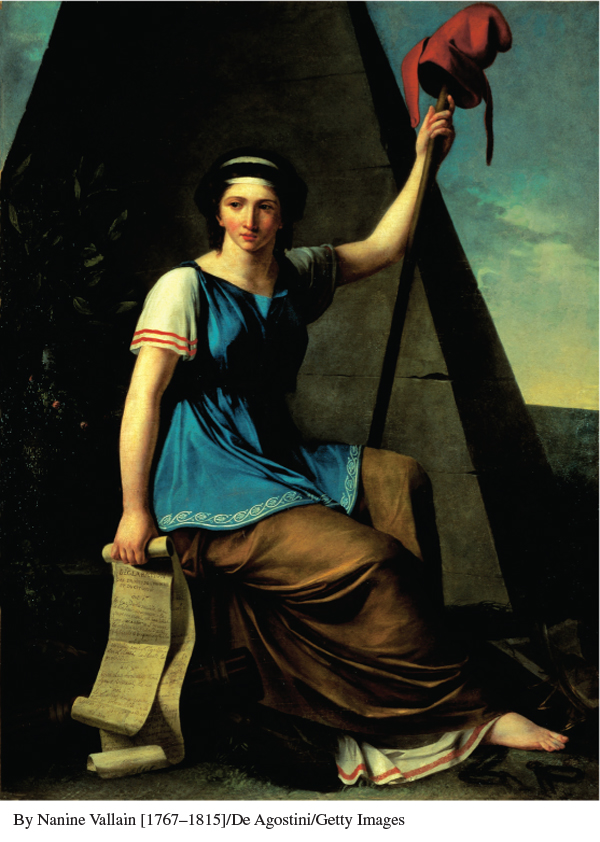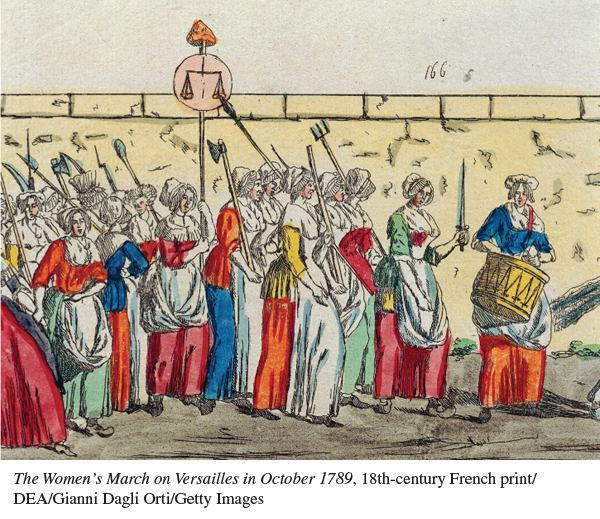A History of Western Society: Printed Page 621
A History of Western Society, Value Edition: Printed Page 598
A History of Western Society, Concise Edition: Printed Page 624
Popular Uprising and the Rights of Man
While delegates at Versailles were pressing for political rights, economic hardship gripped the common people. Conditions were already tough, due to the government’s disastrous financial situation. A poor grain harvest in 1788 caused the price of bread to soar, and inflation spread quickly through the economy. As a result, demand for manufactured goods collapsed, and many artisans and small traders lost work. In Paris perhaps 150,000 of the city’s 600,000 people were unemployed by July 1789.
Against this background of poverty and political crisis, the people of Paris entered decisively onto the revolutionary stage. They believed that, to survive, they should have steady work and enough bread at fair prices. They also feared that the dismissal of the king’s liberal finance minister would put them at the mercy of aristocratic landowners and grain speculators. At the beginning of July, knowledge spread of the massing of troops near Paris. On July 14, 1789, several hundred people stormed the Bastille (ba-

Just as the laboring poor of Paris had decisively intervened in the revolution, the struggling French peasantry also took matters into their own hands. Peasants bore the brunt of state taxation, church tithes, and noble privileges. Since most did not own enough land to be self-
Faced with chaos, the National Assembly responded to the swell of popular uprising with a surprise maneuver on the night of August 4, 1789. By a decree of the Assembly, all the old noble privileges — peasant serfdom where it still existed, exclusive hunting rights, fees for having legal cases judged in the lord’s court, the right to make peasants work on the roads, and a host of other dues — were abolished along with the tithes paid to the church. From this point on, French peasants would seek mainly to protect and consolidate this victory.
On August 27, 1789, the Assembly further issued the Declaration of the Rights of Man and of the Citizen. This clarion call of the liberal revolutionary ideal guaranteed equality before the law, representative government for a sovereign people, and individual freedom. This revolutionary credo, only two pages long, was disseminated throughout France and the rest of Europe and around the world.

The National Assembly’s declaration had little practical effect for the poor and hungry people of France. The economic crisis worsened after the fall of the Bastille, as aristocrats fled the country and the luxury market collapsed. Foreign markets also shrank, and unemployment among the urban working classes grew. In addition, women — the traditional managers of food and resources in poor homes — could no longer look to the church, which had been stripped of its tithes, for aid.
On October 5 some seven thousand women marched the twelve miles from Paris to Versailles to demand action. This great crowd, “armed with scythes, sticks and pikes,” invaded the National Assembly. Interrupting a delegate’s speech, an old woman defiantly shouted into the debate, “Who’s that talking down there? Make the chatterbox shut up. That’s not the point: the point is that we want bread.”2 Hers was the genuine voice of the people, essential to any understanding of the French Revolution. The women invaded the royal apartments, killed some of the royal bodyguards, and searched for the queen, Marie Antoinette, who was widely despised for her frivolous and supposedly immoral behavior. It seems likely that only the intervention of Lafayette and the National Guard saved the royal family. But the only way to calm the disorder was for the king to live closer to his people in Paris, as the crowd demanded.

Liberal elites brought the Revolution into being and continued to lead politics. Yet the people of France were now roused and would henceforth play a crucial role in the unfolding of events.